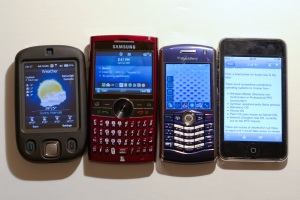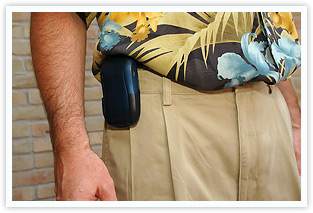So let’s start with the devices that we’re currently using to increase our productivity. Mind you, there’s a limit to how many devices you can use at the same time before you start to lose productivity. (There’s an article in that thought for the future I think.)
A brief primer
There are 6 competitive smartphone operating systems to choose from:
- Windows Mobile (Standard non-touchscreen or Professional PPC touchscreen)
- Symbian (predominantly Nokia phones)
- Blackberry OS
- iPhone OS
- Palm OS (also known as Garnet OS)
- Andriod (Google’s new OS, currently out on the HTC Dream)
There are scores of information out there on each and it would take weeks to review them at length. I will leave that to the professionals, so you can check out comparisons of the first four here.
Each OS has it’s own strengths and limitations. Personally, I’ve always been inclined to go for Windows Mobile as I like the flexibility it provides as well as the seamless integration with MS Exchange server which my company uses to host email. The platform isn’t without fault, and I’ve had moments where I was just about ready to take a sledgehammer to one or more of my WM phones. All in all though, it seems to work (with the right amount of finessing). I”m sure there are many waiting in the wings to debate this point…
The Devices
So enough jabbering – here are the devices currently in use:

Smartphone devices
From left to right, we have: HTC Touch, Samsung Jack (or Blackjack 2), Blackberry Pearl 8120, and an iPod Touch for good measure. I know, the iPod isn’t technically a smartphone, but it has all of the same capabilities minus the (non-wifi) network connectivity, camera and a mic so am including it in our discussion.
This gives us a fairly solid breadth of experience among three different platforms. I’m eager to get my hands on a Symbian phone, but am paralyzed by the often discussed slow syncing of emails. So for the time-being, I remain out of the market for a Nokia phone (although the E71-2 has subtly caught my attention).
Unfortunately, the idea of carrying around 4 different devices is absurd enough to not do it more than once or twice, so what do I keep with me day-to-day? My primary workhorse is the Samsung Jack, backed up by the uber-revolutionizing iPod. I don’t think I could live without one or the other. The Ipod is essential for ease of note-taking (app: Evernote) and list making (app: ShopShop). I use Evernote as well on my Jack, but it expectedly cannot hold a candle to the usability of the iPod version. And of course, the defacto WM email syncing keeps me forever bound to the Jack. The HTC Touch is impressive for it’s time, but is a bit dated and can frustrate you to no end with the lack of hard buttons (notice that this is NOT a drawback on the iPod).
I have opened a few different doors and will be walking through each of these in due time. For now, I will leave you with these thoughts when it comes to picking the hardware to meet your needs:
Things to look for in a smartphone
The Operating System. See above and choose the one you like. Keep in mind that more mature systems (e.g. Windows Mobile, Symbian) have more 3rd party applications to choose from. The caveat is that both RIM and Apple now have appstores to make it easy for you to download what you want. And don’t forget about email integration. This will be the last time I mention it in this post, but the most powerful integration solution comes with Windows or BB BES. Everything is else is second place.
Keyboard. The most noticeable distinction between phones outside of the actual OS is the presence of a hard keyboard. How often to you plan on typing with your device? How stubby or slim are your fingers? I don’t actually have a strong preference one way or the other as I am just as quick to type on the Touch as I am the Jack, but my general recommendation is to go with a hard keyboard. In addition to providing tactile feedback, the keys make great shortcuts to different applications that can save you time with menu-intensive operating systems.
Physical Phone Size. How do you want to carry your phone? If you have a purse/murse, problem solved. If not, deciding whether or not to wear a holster can be a tough choice. The leather blackberry holsters can seem professional, and the more people that wear them the more natural it looks, but there are still some holdouts that find the “clipped to my belt/pant pocket/waistband” look ridiculously silly, especially in more casual attire. Here’s an example:

Holstered phone. Slick.
Horsepower. If you want to be productive, you need speed (cpu speed, not the drug which also eerily fits this sentence). Phone’s tend to lag when you try to do too much, which is one of the reasons why the iPhone doesn’t allow you to multitask aside from their music player. The CPU speed isn’t always indicative of how fast the device is; the make and model as well as the OS play a big part. Read some reviews, google some performance tests or actually try the thing first if you can.
Resale value. It may not be as important to you if you’re still carrying a Palm Treo 650 or if you’re with a CDMA (Sprint, Bell etc) carrier where the phones aren’t as easily interchangeable. But if you’re on GSM, you might be inclined to upgrade more often than your contract subsidizes for, which means grey market (craigslist anyone?).
What else do you look for in a phone?
Once we get into the tools, it will be easier to make a decision as what you get out of it should be driven by how you intend to use it to enhance your productivity.
PSp
Leave a comment